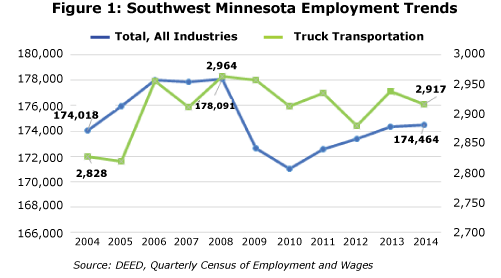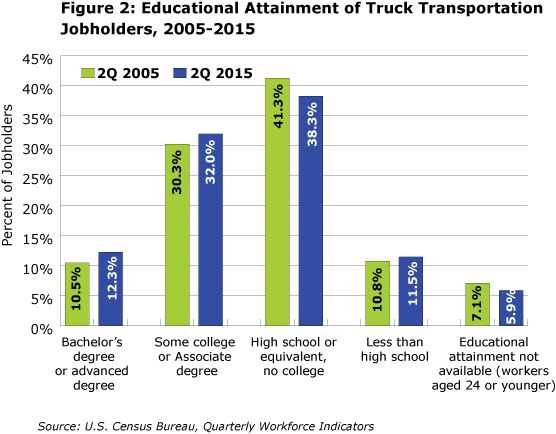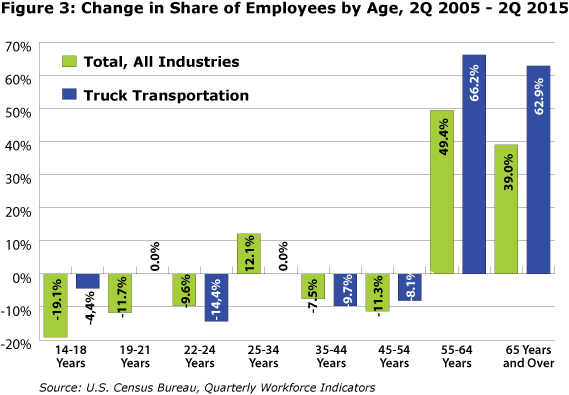by Luke Greiner and Mark Schultz
March 2016
Truck transportation is a big deal in Southwest Minnesota, where these jobs are nearly twice as concentrated as statewide. Truck transportation plays a critical role in Southwest Minnesota's economy, allowing many other industries to produce and ship goods and provide services to consumers.
While there are many different sectors within the transportation industry, including air, water, rail, and pipeline, truck transportation is the largest sector in the region, providing more than half (54 percent in the third quarter of 2015) of transportation and warehousing industry jobs in Southwest Minnesota. In sum, there were 429 truck transportation business establishments providing 3,354 jobs and nearly $34 million in total payroll in the third quarter of 2015.
Like the regional economy, the truck transportation sector has certainly experienced its fair share of ups and downs in recent years. In fact, employment levels in Southwest Minnesota have not yet rebounded to their pre-recession peaks, either in truck transportation or the total of all industries.
On an annual basis, truck transportation peaked with 2,964 jobs in 2008, sank as low as 2,880 in 2012, and remained 47 jobs below break-even at 2,917 jobs in 2014. Recent quarterly data show the sector is running ahead of where it was last year, so it may reach a new annual high in 2015. Even though truck transportation lost 1.6 percent of its jobs from 2008 to 2014, the decline was less than the 2 percent overall job decline during the same period (see Figure 1).

After accelerating to $38,116 in 2014, the highest on record, average annual wages were about 3 percent higher in truck transportation than the average for all industries. Wages in truck transportation have typically been higher than the average annual wage in the region, with the 3 percent wage advantage in 2014 being the second smallest gap dating back to 2004.
Similar to the employment fluctuations, average annual wages have also been somewhat inconsistent over time. In 2009 average annual wages for truck transportation actually decreased 2.6 percent compared to a modest gain of 0.7 percent for all industries in Southwest Minnesota.
Data from the U.S. Census Bureau's Quarterly Workforce Indicators (QWI) provide a detailed look into how the truck transportation labor force has been changing over time. The most recent QWI data are from the second quarter of 2015, and all comparisons made in this article will use second quarter data to control for seasonal variations.
Perhaps not surprisingly, males hold 87.6 percent of truck transportation jobs in Southwest Minnesota, compared to just 48.3 percent of all jobs in the region. The same gender imbalance holds true in the state as a whole, where 85.4 percent of truck transportation jobs are held by men. The ratio of men to women in the industry has remained virtually unchanged since 1995.
Unlike gender, the educational level of job holders in Southwest Minnesota saw some changes in the past decade. From the second quarter of 2005 to the second quarter of 2015, workers in truck transportation increased their education. The most common education level in truck transportation is a high school diploma or GED, but that share is decreasing. The percentage of jobholders with a high school diploma or less fell from 52.1 percent in 2005 to 49.8 percent in 2015 (see Figure 2).

The share of employees with some college or an Associate degree expanded to 32 percent, and workers with a Bachelor's degree or higher rose from 10.5 percent to 12.3 percent. Compared to statewide trends, the share of truck transportation jobholders with a Bachelor's degree or higher increased over twice as fast in Southwest Minnesota, and employees with some college or an Associate degree increased more than 4.5 times faster.
The biggest changes in workforce composition occurred in age groups. Truck transportation workers are older, with 55 to 64 year olds being the largest cohort, holding almost 27 percent of jobs compared to about 19 percent across all industries. In fact, 38 percent of jobs in truck transportation are held by workers aged 55 years or older, compared to 25 percent for all industries in the region.
The aging of the workforce is occurring in all industries, but it has been much more pronounced in truck transportation. From the second quarter of 2005 to the same quarter in 2015, the share of workers aged 55 to 64 increased 66.2 percent, almost 17 percent faster than the increase across all industries. Even larger was the increased share of workers aged 65 years or older in truck transportation, which jumped almost 25 percent more than all industries (see Figure 3).

Possibly more important than the increased share of workers in the two oldest age cohorts is the decline of jobs held by everyone else. The number of workers younger than 55 decreased 6.9 percent from 2005 to 2015, and the second largest age cohort in truck transportation is currently 45 to 54 years old with 27.4 percent of jobs. This group will be joining the oldest age cohorts in the next decade. Replacing Baby Boomers will be a concern for all industries in Southwest Minnesota, but the need in truck transportation is likely to be even greater.
Although the truck transportation sector contains a variety of jobs aside from driving, the most common and well known jobs are heavy and tractor trailer truck drivers and light truck and delivery services drivers. According to data from DEED's Occupational Employment Statistics, there are almost 4,400 of these truck drivers employed in Southwest Minnesota, not including those who are self-employed.
These truck drivers work not only in truck transportation, but many other industries as well, such as wholesale trade, retail trade, and manufacturing. Because of their diverse distribution, demand for truck drivers in Southwest Minnesota remained strong whether overall employment levels were going up or down. Truck drivers are currently ranked in the top 10 occupations in demand in the region.
Other occupations in the truck transportation sector include laborers and freight movers, truck mechanics and diesel engine specialists, dispatchers, office clerks, and supervisors and managers, although these jobs were also found in other industries. Surprisingly, wage data show that several of these jobs earn less in trade, transportation, and utilities than the total of industries (see Table 1).
| Table 1: Largest Occupations in Truck Transportation, Southwest Minnesota | ||||
|---|---|---|---|---|
| Total, All Industries | Trade, Transportation, and Utilities Industry | |||
| Estimated Regional Employment | Median Hourly Wage | Estimated Regional Employment | Median Hourly Wage | |
| Heavy and tractor-trailer truck drivers | 3,400 | $17.23 | 2,500 | $17.09 |
| Laborers and freight, stock and material movers, hand | 2,630 | $14.13 | 1,130 | $13.56 |
| Light truck or delivery services drivers | 960 | $14.81 | 830 | $15.16 |
| Bus and truck mechanics and diesel engine specialists | 470 | $18.26 | 190 | $17.10 |
| Dispatchers, except police, fire, and ambulance | 240 | $18.12 | 130 | $18.80 |
| Office clerks, general | 3,160 | $13.51 | 460 | $11.43 |
| First-line supervisors of transportation and material-moving machine and vehicle operators | 190 | $20.68 | 130 | $18.90 |
| General and operations managers | 2,030 | $35.57 | 570 | $33.68 |
| Industrial truck and tractor operators | 860 | $16.81 | 200 | $12.92 |
| Secretaries and administrative assistants | 1,880 | $15.65 | 200 | $12.56 |
| Total, All Occupations | 177,030 | $15.48 | 34,350 | $12.91 |
| Source: DEED Occupational Employment Statistics (OES) program | ||||
The wage differences may be important when looking at the wages needed to meet basic cost of living needs in the region. According to DEED's Cost of Living tool, a single person in Southwest Minnesota would need to make $10.26 per hour to cover a basic cost of living, which most truck transportation occupations surpass.
However, a partnered couple with one full-time and one part-time job and one child would need to earn $13.25, and a single person with one child would need to make $15.47 per hour (see Table 2). While several occupations earn well above those thresholds, some do not, especially in the Trade, Transportation, and Utilities industry. Truck transportation firms looking for laborers and freight movers, office clerks, industrial truck and tractor operators, and secretaries may need to look at market wages in comparison to the region's cost of living to attract new workers.
| Table 2: Cost of Living in Southwest Minnesota | |||||||||
|---|---|---|---|---|---|---|---|---|---|
| Household Size (Work Status) | Total Yearly Cost | Required Hourly Wage | Monthly Costs | ||||||
| Child Care | Food | Health Care | Housing | Transportation | Other | Taxes | |||
| Single – No Children | $21,348 | $10.26 | $0 | $362 | $134 | $541 | $429 | $127 | $186 |
| Single – 1 Child | $32,172 | $15.47 | $418 | $471 | $283 | $701 | $539 | $164 | $105 |
| Partnered (1 FT) – 0 Children | $29,268 | $14.07 | $0 | $616 | $293 | $550 | $594 | $163 | $223 |
| Partnered (1 FT) – 1 Child | $36,048 | $17.33 | $0 | $766 | $398 | $701 | $711 | $205 | $223 |
| Partnered (1 FT/1 PT) – 0 Children | $32,064 | $10.28 | $0 | $616 | $293 | $550 | $778 | $163 | $272 |
| Partnered (1 FT/1 PT) – 1 Child | $41,352 | $13.25 | $209 | $766 | $398 | $701 | $933 | $205 | $234 |
| Partnered (2 FT) – 0 Children | $32,064 | $7.71 | $0 | $616 | $293 | $550 | $778 | $163 | $272 |
| Partnered (2 FT) – 1 Child | $45,036 | $10.83 | $418 | $766 | $398 | $701 | $933 | $205 | $332 |
| Source: DEED, Cost of Living Data Tool | |||||||||
According to DEED's Job Vacancy Survey (JVS), transportation and warehousing employers in Southwest Minnesota reported 426 vacancies in the second quarter of 2015, more than double the average number of vacancies posted over the past five years. Of these openings, less than one-third are part-time, and only 29 percent are temporary or seasonal.
Jobseekers who aren't interested in college may be interested to learn that just 13 percent of the vacancies required postsecondary education, although 65 percent require a certificate or license - most likely a Class A Commercial Driver's License, which can be earned at a variety of technical colleges or truck driver training academies. Work experience also makes an individual more competitive for these vacancies, with 29 percent requiring one or more years of experience.
Not only are there current vacancies, but projections show that the truck transportation sector has a bright future ahead of it. According to DEED's Employment Outlook data, truck transportation in Southwest Minnesota is projected to grow by nearly 200 more jobs, a 6.5 percent increase.
At the occupational level, heavy and tractor-trailer truck drivers are expected to be both the fastest growing and also add the largest number of new jobs from an additional 341 new jobs in addition to the 750 expected replacement openings. Most of the other truck transportation occupations are not expected to see much new growth, but will have significant needs for replacement workers to fill in for Baby Boomers who transition out of the labor force.
Truck driving is currently a high demand occupation in Southwest Minnesota, and is expected to stay that way in the future. So as the famous saying goes, "Keep on Truckin'."